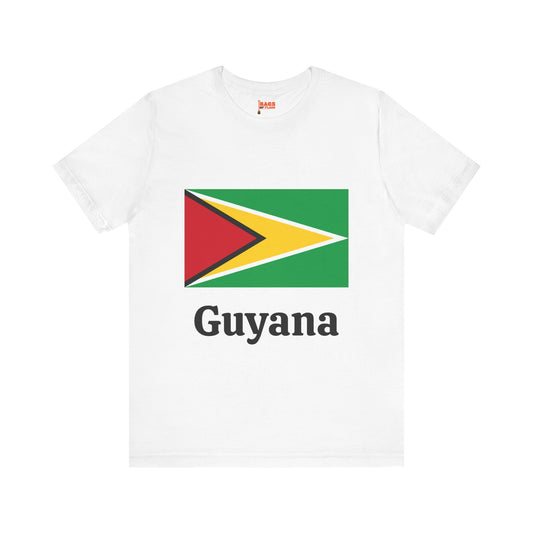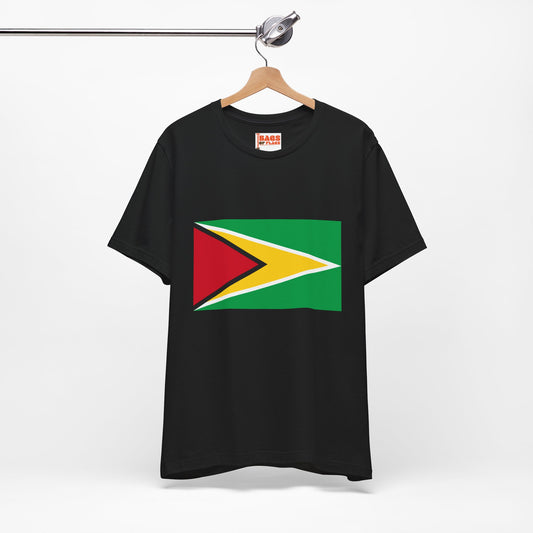-
Guyana Pillow
Regular price $22.65 USDRegular priceUnit price / per -
Guyana Backpack
Regular price $59.79 USDRegular priceUnit price / per -
Guyana Leather Patch Hat
Regular price $18.85 USDRegular priceUnit price / per -
Guyana Flag Sweatshirt
Regular price $34.15 USDRegular priceUnit price / per -
Guyana Sweatshirt
Regular price $34.15 USDRegular priceUnit price / per -
Guyana Mug
Regular price $11.65 USDRegular priceUnit price / per -
Guyana Trucker Cap
Regular price $14.90 USDRegular priceUnit price / per -
Guyana Hoodies
Regular price $34.40 USDRegular priceUnit price / per -
Guyana T-shirts
Regular price $22.79 USDRegular priceUnit price / per -
Guyana Flag Hoodies
Regular price $34.40 USDRegular priceUnit price / per -
Guyana Flag on T-shirt
Regular price $22.79 USDRegular priceUnit price / per
Collection: Guyana
The Guyana flag, also known as the flag of Guyana, is a symbol of pride and unity for the South American nation. It holds historical significance and represents the country's cultural diversity. We will delve into the unique facts and protocols surrounding the Guyana flag, covering its design, historical context, symbolism, current relevance, and additional interesting facts.
Overview of the Guyana Flag's Design and Colors

The flag of Guyana, often referred to as the Golden Arrowhead, showcases a striking design characterized by its vibrant colors and bold geometry. It predominantly features a rich green background, symbolizing the nation's lush landscapes and commitment to agriculture and forestry. The standout feature is the golden arrow pointing towards the hoist side, representing Guyana's aspiration towards a bright future and its mineral resource wealth.
This arrow is bordered by two narrow stripes: white, indicating the rivers and water resources vital to the country's prosperity, and black, denoting the resilience and endurance of its people. Complementing these elements is the red triangle adjacent to the hoist, a vivid expression of the Guyanese population's vitality, zeal, and enthusiasm as they forge ahead. Together, these elements create a visually captivating flag and weave a narrative of a nation rich in natural beauty, resources, and the indomitable spirit of its people.
Historical Context of the Guyana Flag

The journey toward creating the Guyana flag began in anticipation of the nation's independence from British colonial rule. Officially adopted on May 26, 1966, the day Guyana declared its sovereignty, the flag represented a new beginning and the aspirations of a free nation. Whitney Smith, a renowned American vexillologist, was the mastermind behind its design, which was selected to embody the country's identity and values on the global stage. Since its adoption, the flag, with its distinctive design and colors, has flown to symbolize the nation's pride, unity, and the rich diversity of its people and landscapes. Over the years, the flag has remained unchanged, steadfastly representing Guyana's enduring spirit and commitment to progress. Its inception was a landmark event, signifying the culmination of the struggle for independence and the dawn of a new era in Guyanese history.
Symbolism Behind the Guyana Flag
The symbolism imbued in the Guyana flag is rich and reflects the country’s aspirations, values, and heritage. The dominant green background is not just a nod to Guyana's verdant landscapes; it also symbolizes the nation's commitment to environmental preservation and the pivotal role of agriculture and forests in its economy. The gold arrow, central to the design, is a beacon of hope, pointing towards a future filled with prosperity and success, highlighting Guyana’s vast mineral wealth, including bauxite, gold, and diamonds.
Surrounding the golden arrow, the white and black fimbriations serve dual purposes. The white stripe symbolizes the purity of the nation’s waterways and the value of water as a precious natural resource, essential for life and sustenance. In contrast, the black stripe is a powerful representation of the resilience and strength of the Guyanese people. It acknowledges the challenges the nation has faced and overcome, symbolizing the endurance required to protect and build its future.
The red triangle, positioned adjacent to the hoist side, brings an element of dynamism to the flag’s symbolism. It represents the zeal, enthusiasm, and vigor of the Guyanese people. This color evokes the spirit of sacrifice and the passion that has driven the country’s struggle for independence and continues to propel it toward growth and development. Each element of the flag’s design harmonizes to tell a story of unity, strength, and optimism for Guyana’s future.
Current Relevance of the Guyana Flag
In today's Guyana, the flag not only adorns government edifices and marks its presence at official events but also plays a pivotal role in the collective consciousness of its citizens. It is a visual articulation of national pride, seen fluttering in schools, local businesses, and public spaces, symbolizing the unity and diversity of the country. Beyond its ceremonial use in military parades and national celebrations, the flag embodies the aspirations and achievements of the Guyanese people.
Despite the occasional emergence of controversies, often rooted in the political landscape, the flag transcends these disputes, standing as a beacon of hope and progress. It fosters a sense of belonging among the citizens, reminding them of their shared heritage and the common future they strive towards. This enduring symbol continues to inspire a sense of duty and patriotism, encouraging the nation to uphold the values it represents. In essence, the flag of Guyana remains a powerful icon of national identity, respected and cherished across the country, as it waves high against the backdrop of Guyana's evolving story.
Additional Facts About the Guyana Flag
When displaying the flag of Guyana, a set of established protocols is adhered to, emphasizing the respect and reverence with which the nation holds this symbol. Among these, a cardinal rule is that the flag must never be allowed to make contact with the ground, reflecting the dignity and sovereignty it represents. Additionally, the flag is to be hoisted and lowered in a manner that is both respectful and ceremonial, ensuring that these actions mirror the significance of the flag itself.
Unique among world flags, the Guyana flag's design incorporates an arrow, a distinctive feature that sets it apart and underscores the forward-looking aspirations of the nation. This design choice is not only symbolic but also contributes to the flag's visual identity on the international stage.
Another protocol involves the tradition of flying the flag at half-mast during periods of national mourning or to commemorate significant events. This practice serves as a visual expression of the country's collective grief or remembrance, unifying its citizens in solidarity and reflection.
These protocols and practices surrounding the flag of Guyana are not just about the flag's physical handling or display. They are deeply imbued with the values and pride of the Guyanese people, reflecting their respect for their nation's history, achievements, and aspirations for the future.






















